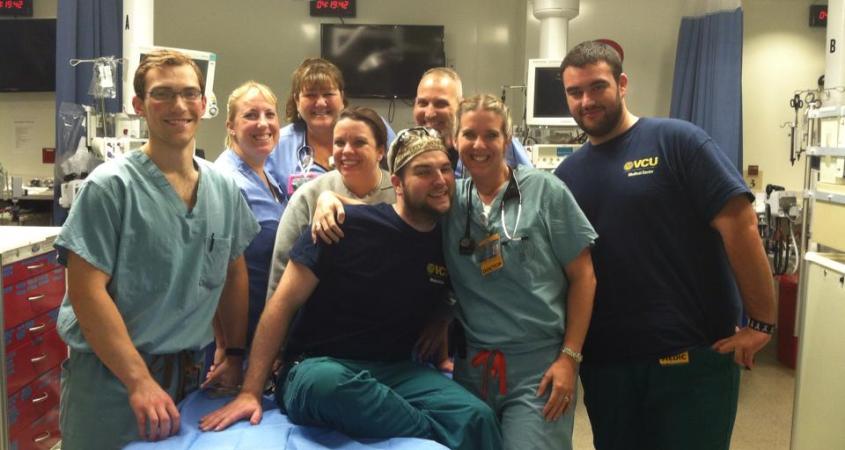Everyone warns you that intern year is hard. It’s a year of little sleep, a rollercoaster of emotions both good and bad. Frustration and guilt in wanting to know everything now because everything you don’t know might be what matters for this patient, this time. And tremendous successes. Some of the things I did this year, I really can’t believe I was able to do. And survive. Mostly, I’ve learned a lot about myself, and have been reminded yet again that I work with an amazing group of people.
Here are a few of the ups and downs of my intern year in emergency medicine:
UP: Running a trauma when I thought I could never do it.
I have a distinct memory of standing in the trauma bay at Norfolk General Hospital, watching the trauma team work its perfectly organized chaotic magic. I paid particular attention to the young female physician leading the whole thing — inserting an airway, calling out physical exam findings, doing an eFAST ultrasound to look for bleeding. I remember hoping, wishing I could ever have her confidence and calm demeanor. That thought was followed quickly by being thankful I wasn’t yet in the spotlight myself. I could never do that, right? In September, I ran my first Delta trauma at a Level I Trauma Center and I survived to do it again.
DOWN: Those two-week stretches not seeing my husband.
I had no idea how much I need my husband to help me feel like a normal, healthy, centered human being. Amir and I had several two-week stretches this year where he was on nights and I was on days, or vice versa. One day we were so desperate for a date we coordinated a 20-minute coffee meet-up at the Au Bon Pain in the hospital. Let’s not talk about what the house or laundry pile looked like during those stretches. This is the video we play each other if we ever need a pick-me-up.
UP: Procedures, procedures, procedures.
Open thoracotomy, paracentesis, lumbar puncture. Viewer discretion advised.
Not to mention intubations, central lines, suturing, joint reductions, even a C-section … you get the idea. I get to work with my hands a lot.
DOWN: Crying in the ICU.
So, I’m a crier. Always have been. I have distinct memories of my dad trying to help me with math homework as a kid. I would get frustrated and cry (my stress response) and my dad would then get frustrated because I was crying. “What’s crying going to solve?” he used to ask me, which of course made me cry more.
To be honest, I was expecting to cry multiple times during the first few months of residency. I actually made it to late February before it happened. Combine working 12 to 14 hours a day, 11 days in a row, with little sleep, food, potty breaks or non-medical human interaction (one of those two-week stretches). Now add to that a dozen of the sickest patients in the hospital. I broke down — red face, tears, snot, the whole nine yards.
The nice thing about intern year, though, is that everyone around you has been there, so I had about four senior residents and three PAs share their own crying stories to help pick me up. And that’s what you learn to do — pick yourself up, learn and keep going.
UP: Finally learning my way around the hospital (which is actually four hospitals).
Anyone who works in an old hospital knows how the building gets added onto over the years, creating a behemoth maze of windowless hallways and floors that don’t match. “Take the elevator to the fifth floor of North Hospital, turn left and you’ll be on the first floor of Main Hospital.” As if there weren’t enough to learn as an Intern.
DOWN: Cancer. I diagnose a lot of cancer.
I didn’t go into oncology for a reason. It takes the smartest, strongest, most energized people to be cancer doctors. As an emergency physician, I expected to treat people with cancer but I hadn’t thought of cancer as something I would diagnose. I guess I assumed that people would present to their PCP with concerning symptoms, then get an outpatient workup and diagnosis by a specialist. But people do come to the ED for hematuria (blood in the urine), anorexia (lack of appetite), back pain and weakness. And sometimes at the end of the workup, it’s cancer.
UP: Baby Mint Mochachino for a dying patient.

I’ve seen a lot of amazing, caring people do a lot of touching things in the medical setting. But one moment stands out from this year. I had a patient who had chosen to pursue hospice care. He couldn’t stop telling me how beautiful his wife was and how he looked forward to seeing her soon. He had stopped eating and drinking days ago, so when he asked me for a “real coffee,” I was intrigued. He’d requested a cup of coffee from the medical student who poured him a cup of the hospital grade mud available to all employees. His dying wish was to have a real cup of coffee.
How reasonable. I went to the coffee counter, told the story to the barista, and she whipped up the only coffee worthy of such a role — a baby mint mochachino — which she made with honor and pride in her work, even adjusting the temperature down to avoid any burned tongues.
So, that’s it. Intern year is coming to a close, and July first I’ll be a “senior resident,” fraught with its own challenges and lessons to be learned.
Editor’s note: A version of this piece first appeared at TeamLouka on May 11, 2015.


